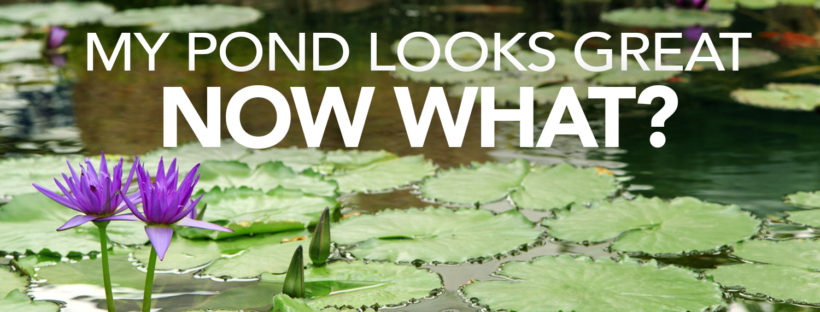A few months ago we started with the question that I hear more than most. That was, how does my pond work anyway? In that blog I gave the basics of the biology in your pond and even compared it to a goldfish bowl. Basically they work the same way. We can do so much more with a pond because of biological filtration and plants.
 Well, Atlantic Water Gardens National Sales Manager, Jim Chubb and Director of Product Information, Demi Fortuna, both followed that blog post with articles on biological filtration and how bogs work (plant filtration). By now you should feel pretty good about how your pond works and how to keep it looking clean, clear, and natural. Some might be even getting ready to ask the follow up question of, “I have done all this, but I still have to do a pond clean out every year, why?” That is not only a good question, but the answer is the next step in the solution to keeping your pond clean and clear as possible.
Well, Atlantic Water Gardens National Sales Manager, Jim Chubb and Director of Product Information, Demi Fortuna, both followed that blog post with articles on biological filtration and how bogs work (plant filtration). By now you should feel pretty good about how your pond works and how to keep it looking clean, clear, and natural. Some might be even getting ready to ask the follow up question of, “I have done all this, but I still have to do a pond clean out every year, why?” That is not only a good question, but the answer is the next step in the solution to keeping your pond clean and clear as possible.
Let me explain, you have set  up everything you could to put the water feature on the right path. All the biology is working for you and it is simple to see that the plants growing and out competing the algae for nutrients. You end the summer season happy, coast along until winter and wait for spring. Then what happens? You guessed it, there are algae blooms of every kind and your frustration level is through the roof. You thought you had this covered. What Happened?
up everything you could to put the water feature on the right path. All the biology is working for you and it is simple to see that the plants growing and out competing the algae for nutrients. You end the summer season happy, coast along until winter and wait for spring. Then what happens? You guessed it, there are algae blooms of every kind and your frustration level is through the roof. You thought you had this covered. What Happened?
You probably forgot the last step, harvesting. Huh? Harvesting, what am I a farmer? Indeed you are, or at least you need to be. You see, all that time and attention that you gave led to great plant growth. Those plants are full of nutrients and need to be cut and removed from the water feature before they start to die off and decay in the water. By trimming plants back and covering the pond with a net at the end of the season each year, we are removing nutrients, preventing leaves and other organics from getting into the pond. We are simply getting it ready for the next season. By doing this you complete the cycle and prevent all the nutrients from reentering the pond all at once in the spring.
So many water feature owners over look this last step. Yes, they will cut back ugly plants that the cold weather has taken its toll on. But by then the damage has been done. Look at your floating plants, in season they are bright green and beautiful. If you pick one up it has long roots that stretch way out from the bottom to the plant. What is difficult to see though, is that as soon as we see night time temps start to drop, the plant starts to change. First it is the growth rate, then it’s the root system. In a floating plant there are a ton of nutrients in the root system. As it gets colder it starts to drop its roots. When the weather maintains the cold temperature the floater finally starts to turn brown and is usually removed. But it was the root system that did the damage. All those nutrient loaded roots are now at the bottom of the pond decaying and getting ready to spring into action next spring. Your marginal plant do something similar and need to be trimmed as well.
So, make a note and be sure to trim plants back before the weather turns cooler, cover with a net to keep leaves and falling debris from getting in there as the season changes. And you will be one step ahead for next spring.
About the Author:
 SEAN BELL
SEAN BELL
Sean is the Regional Sales Manager for the Southeast for Atlantic Water Gardens. Fish Geek and water feature enthusiast, Sean has managed one of the largest aquarium stores in the Southeast while running his own pond maintenance company. When it comes to water features, Sean is your guy!



It is a challenge to keep away raccoon form pond. By following your tips raccoon or any other pet will not attract to pond. Creating small caves in pond is good idea to safe fish. For creating caves be aware of leaks and cracks. For waterproof pond surface apply EPDM Pond Liner.
It is important to know how to properly maintain your pond throughout the year. Great information, thanks for sharing!